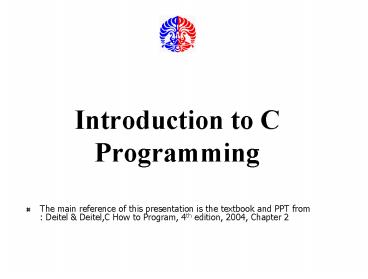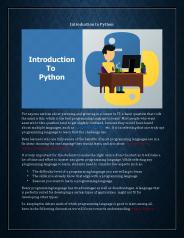Introduction to C Programming - PowerPoint PPT Presentation
1 / 34
Title:
Introduction to C Programming
Description:
The main reference of this presentation is the textbook and PPT from : Deitel ... Integer division truncates remainder. 7 / 5 evaluates to 1 ... – PowerPoint PPT presentation
Number of Views:106
Avg rating:3.0/5.0
Title: Introduction to C Programming
1
Introduction to C Programming
- The main reference of this presentation is the
textbook and PPT from Deitel Deitel,C How to
Program, 4th edition, 2004, Chapter 2
2
Assistant Class B
- Suharjono 04 1-19
- Ario Santoso 04 20-48
- Sutanto Sugii Joji 04 49-57
3
Outline
- History of C
- A Simple C Program Printing a Line of Text
(Hello World) - Another Simple C Program Adding Two Integers
- Memory Concepts
- Arithmetic in C
- Decision Making Equality and Relational
Operators
4
History of C
- C
- Evolved by Ritchie from two previous programming
languages, BCPL and B - Used to develop UNIX
- Hardware independent (portable)
- By late 1970's C had evolved to "Traditional C"
- Standardization
- Many slight variations of C existed, and were
incompatible - Committee formed to create a "unambiguous,
machine-independent" definition - Standard created in 1989, updated in 1999
5
The C Standard Library
- C programs consist of pieces/modules called
functions - A programmer can create his own functions
- Advantage the programmer knows exactly how it
works - Disadvantage time consuming
- Programmers will often use the C library
functions - Use these as building blocks
- Avoid re-inventing the wheel
- If a premade function exists, generally best to
use it rather than write your own - Library functions carefully written, efficient,
and portable - Using ANSI Standard Library will improve program
performance portability
6
Compiling Executing C Programs
- Preprocessors
- Accept C source files as input and produces a
file that is passed to the compiler - Compiler
- Translate the C language source code into the
machine code - Linker
- Combines the function/library defined in the
other source file - When a function is called, linker locates it in
the library - Inserts it into object program
- If function name is misspelled, the linker will
produce an error because it will not be able to
find function in the library
7
A Simple C ProgramPrinting a Line of Text
Hello World
Hello World!
8
- Comments
- Text surrounded by / and / is ignored by
computer - Used to describe program
- Indicating program structure and contributing to
program clarity and correctness - Comment should be written simultaneously with
program text. - Frequently beginners leave the inserting of
comments as a last step - If program is running ? omit or abbreviate the
comment - include ltstdio.hgt
- Preprocessor directive
- Tells computer to load contents of a certain file
- ltstdio.hgt allows standard input/output operations
9
Component of C Program
- int main()
- C programs contain one or more functions,
exactly one of which must be main - Parenthesis used to indicate a function
- int means that main "returns" an integer value
- Braces ( and ) indicate a block
- The bodies of all functions must be contained in
braces
10
Component of C Program (cont)
- printf( Hello World!\n" )
- Instructs computer to perform an action
- Specifically, prints the string of characters
within quotes (" ") - Entire line called a statement
- All statements must end with a semicolon ()
- Escape character (\)
- Indicates that printf should do something out of
the ordinary - \n is the newline character
11
Common Escape Sequences
12
Component of C Program (cont)
- return 0
- A way to exit a function
- return 0, in this case, means that the program
terminated normally - Right brace
- Indicates end of main has been reached
13
Welcome to C!
14
fig02_04.cProgram Output
WelcometoC!
15
fig02_05.c
16
Program Output
Enter first integer45Enter second
integer72Sum is 117
17
C ProgramAdding Two Integers
- As before
- Comments, include ltstdio.hgt and main
- int integer1, integer2, sum
- Definition of variables
- Variables locations in memory where a value can
be stored - int means the variables can hold integers (-1, 3,
0, 47) ? data types - Definitions appear before executable statements
- If an executable statement references and
undeclared variable it will produce a syntax
(compiler) error
18
Variable names (identifiers)
- Identifiers consist of letters, digits and
underscores( _ ) - Cannot begin with a digit
- Case sensitive
- examples
- integer1, integer2, sum
- N, x, a2
- Illegal variable
- Notme
- 2ai
- -plus
- Some identifiers reserved in C language as
keyword ? do not use as identifiers - ANSI C recognize 32 first characters
19
Cs Reserved Keyword
20
Variable names
- Choose the meaningful variable names
- Use some conventions for identifiers
- Underscore conventions long_variable_name
- Capwords conventions longVariableName
21
C ProgramAdding Two Integers
- scanf( "d", integer1 )
- Obtains a value from the user
- scanf uses standard input (usually keyboard)
- This scanf statement has two arguments
- d - indicates data should be a decimal integer
- integer1 - location in memory to store variable
- is confusing in beginning for now, just
remember to include it with the variable name in
scanf statements - When executing the program the user responds to
the scanf statement by typing in a number, then
pressing the enter (return) key
22
C ProgramAdding Two Integers
- (assignment operator)
- Assigns a value to a variable
- Is a binary operator (has two operands)
- sum variable1 variable2
- sum gets variable1 variable2
- Variable receiving value on left
- printf( "Sum is d\n", sum )
- Similar to scanf
- d means decimal integer will be printed
- sum specifies what integer will be printed
- Calculations can be performed inside printf
statements - printf( "Sum is d\n", integer1 integer2 )
23
Memory Concepts
- Variables
- Variable names correspond to locations in the
computer's memory - Every variable has a name, a type, a size and a
value - Whenever a new value is placed into a variable
(through scanf, for example), it replaces (and
destroys) the previous value - Reading variables from memory does not change
them - A visual representation
24
Memory Concepts
- A visual representation (continued)
117
25
Arithmetic
- Arithmetic calculations
- Use for multiplication and / for division
- Integer division truncates remainder
- 7 / 5 evaluates to 1
- Modulus operator() returns the remainder
- 7 5 evaluates to 2
- Operator precedence
- Some arithmetic operators act before others
(i.e., multiplication before addition) - Use parenthesis when needed
- Example Find the average of three variables a, b
and c - Do not use a b c / 3
- Use (a b c ) / 3
26
Arithmetic operators
27
Rules of operator precedence
28
Decision Making Equality and Relational Operators
29
Decision Making Equality and Relational Operators
- Executable statements
- Perform actions (calculations, input/output of
data) - Perform decisions
- May want to print "pass" or "fail" given the
value of a test grade - if control statement
- Simple version in this section, more detail later
- If a condition is true, then the body of the if
statement executed - 0 is false, non-zero is true
- Control always resumes after the if structure
- Keywords
- Special words reserved for C
- Cannot be used as identifiers or variable names
30
Decision Making Equality and Relational Operators
31
fig02_13.c (Part 1 of 2)
32
Enter two integers, and I will tell you the
relationships they satisfy 3 73 is not equal to
73 is less than 73 is less than or equal to 7
33
Program Output (continued)
Enter two integers, and I will tell you the
relationships they satisfy 7 77 is equal to 77
is less than or equal to 77 is greater than or
equal to 7
Enter two integers, and I will tell you the
relationships they satisfy 22 1222 is not equal
to 1222 is greater than 1222 is greater than or
equal to 12
34
Decision Making Equality and Relational Operators































